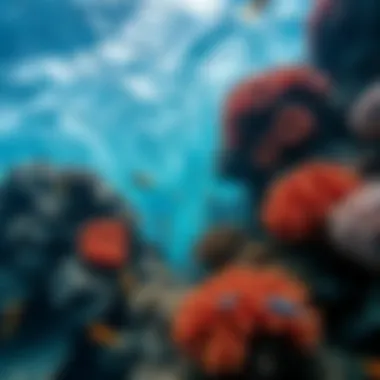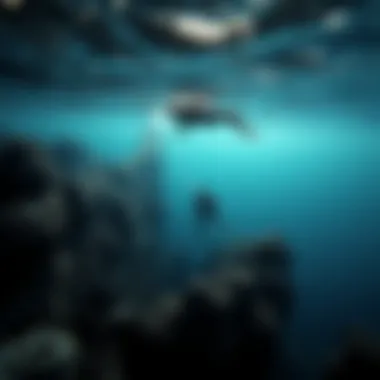Intriguing Aspects of the Ocean: Delving Deeper


Intro
The ocean is a vast and mysterious realm that captivates the imagination of many, surf lovers and environmental advocates alike. With its ever-changing tides and deep blue depths, it offers more than just a playground for surfing. The relationship between the ocean’s health and surfing culture is more intertwined than one might think. To truly appreciate it, one needs to grasp several aspects that define the ocean.
From a biological and physical standpoint, the ocean is teeming with life, home to creatures that range from the tiniest plankton to magnificent whales. Each organism plays a role in the balance of marine ecosystems, illustrating how interconnected life beneath the waves is. Unfortunately, the influence of human activity often casts a long shadow over these ecosystems, altering habitats through pollution and overfishing, thus presenting a major concern for both surfers and conservationists.
This discourse explores these intricate layers of the ocean while catering to a diverse audience—surfers eager to enhance their skills and environmentalists committed to promoting ocean preservation. Engaging in watersport is exhilarating, but understanding the undercurrents of its impact on marine life is vital if we are to sustain these beloved waters for generations to come.
As we dive deeper, we will highlight essential surfing techniques that can enhance the experience on the waves, guide readers in choosing the right surfboards tailored to their style, and emphasize the importance of maintaining those boards to ensure longevity. This article aims to build a bridge between the adrenaline rush of riding the waves and the responsibility we have to protect their habitat.
The Ocean: An Overview
The ocean, covering over 70% of our planet's surface, is not just a body of water; it's a vast realm filled with mysteries and wonders that profoundly affect life on Earth. Understanding the ocean's significance is fundamental to appreciating its role in global systems. It acts as a regulator of climate, a habitat for an incredible variety of species, and a source of resources crucial for human livelihood. This overview will touch on the essential elements and benefits that make the ocean a focal point of this article.
In this article, we aim to explore many layers of the ocean, revealing its intricacies. The ocean’s boundaries, the diverse oceans of the world, and the pressing issues it faces due to human interaction will be discussed. This section not only underscores what the ocean is but also sets the stage for a broader conversation about its influence on our climate, weather, and cultural practices.
Defining the Ocean's Boundaries
The ocean's boundaries are more than just geographical markers; they involve understanding the complex interplay of physical features, ecosystems, and human activities. Generally, oceans are divided by continents and major landforms which create distinct regions. The expansive nature of the oceans means defining these boundaries involves marine geology, oceanography, and even the history of ancient trade routes.
It's important to acknowledge that these boundaries do alter based on climatic changes and sea level rise, impacting marine biodiversity and human activities, particularly those influenced by coastlines. Knowing where one ocean begins and another ends, can also affect international laws and regulations about conservation and resource use, an aspect that can’t be ignored in today’s eco-aware society.
The Oceans of the World
Understanding the different oceans is vital. Each has its own unique character, climate systems, and biodiversity.
Pacific Ocean
The Pacific Ocean is the largest of them all, stretching from the Arctic in the north to the Antarctic in the south. This ocean is critical for its diverse ecosystems, housing everything from coral reefs to deep-sea trenches. Its vastness makes it an arena for climatic events, influencing weather patterns across the globe. The unique feature here is the Mariana Trench, the deepest point on Earth, representing humanity's desire to explore and understand the unknown depths.
Atlantic Ocean
The Atlantic Ocean serves as a crucial trade route, connecting numerous cultures throughout history. Its width is home to the Bermuda Triangle, infamous for mysterious maritime incidents, showcasing how human curiosity often meets the unknowable. Furthermore, the Atlantic's currents, such as the Gulf Stream, play a pivotal role in weather patterns that affect agricultural practices on land, showcasing its broader importance beyond just being a body of water.
Indian Ocean
The Indian Ocean is often overlooked compared to its counterparts, but it plays a vital role in global trade routes, particularly for oil. Its unique monsoonal climate can both benefit agriculture and lead to devastating cyclones, making it both a boon and a burden for coastal communities. The ocean's biodiversity, including remarkable coral reefs and dynamic fish populations, further illustrates its ecological importance and the need for conservation efforts.
Southern Ocean
Surrounding Antarctica, the Southern Ocean is notable not just for its frigid waters but also for its essential role in regulating global climate. The unique currents and nutrient patterns here sustain a rich marine ecosystem populated by penguins and seals, making it a key area for scientific study. Understanding this ocean is critical, especially in the wake of climate concerns and how rapidly changing temperatures affect its stability and biodiversity.
Arctic Ocean
The Arctic Ocean, while the smallest, is crucial due to its rapidly changing environment concerning climate change. Melting ice caps are altering habitats and access routes for shipping, creating a pressing need to focus on its conservation. Despite its often harsh conditions, this ocean supports unique species adapted to extreme environments, underlining an urgent need to balance exploration with preservation in the climate crisis era.
Each ocean has characteristics that not only define it geographically but also influence global human activities and natural systems, making them vital subjects of study.
"Exploring the oceans is more than just understanding their boundaries; it's unraveling tales that date back to the dawn of time."
In our ongoing quest to unveil the complexities of the ocean, we must embrace the challenges and responsibilities that come with discovering its treasures.
The Ocean's Role in Climate Regulation
The ocean plays a pivotal role in regulating the Earth's climate. Covering around 71% of our planet, it functions not merely as a water body, but as a complex system that influences weather patterns, temperature, and even carbon cycles. Understanding this intricate dynamic is crucial, especially for surfers, travelers, and outdoor enthusiasts who depend on stable weather and healthy marine environments.
Ocean Currents and Their Impact
Ocean currents are akin to conveyor belts of water that transport heat across the globe. The interplay between warmer and cooler waters is what shapes climates in different regions. For instance, the Gulf Stream brings mild weather to the North Atlantic, while the cold Humboldt Current cools coastal areas in South America.
- These currents affect marine ecosystems, influencing fish migration patterns, which in turn impacts fishing communities and, ultimately, surf conditions.
- In some regions, such as the equator, warm currents rise, facilitating storms and altering rainfall patterns that can affect overall weather stability.
"Without ocean currents, the climate would not be what it is today; they redistribute heat, which is vital for sustaining life on earth."


Additionally, ocean currents can regulate the intensity of tropical storms. Warm surface waters fuel these storms, while currents can either escalate or calm them based on the temperature differences they create. Understanding these currents is essential for predicting surfing conditions, especially during storm seasons.
Carbon Sink: The Ocean's Absorption of CO2
The ocean acts as a significant carbon sink, absorbing about a quarter of the carbon dioxide humans emit into the atmosphere. This process helps to moderate climate change by keeping CO2 levels lower than they would otherwise be. However, this comes with its own set of challenges.
- The ocean's ability to absorb CO2 is not endless. Increasing carbon levels lead to ocean acidification, which threatens marine biodiversity and can ultimately disrupt food chains. This is particularly concerning for surfers and marine life alike, as coral reefs—critical for maintaining biodiversity—are highly sensitive to pH changes.
- Furthermore, as the ocean warms, its ability to absorb CO2 diminishes, which could lead to a feedback loop exacerbating climate change.
In short, the ocean's role in climate regulation is multifaceted and vital, impacting everything from weather patterns to marine life. For those who surf or engage in water-based activities, recognizing how their actions affect this delicate balance is crucial for sustainable interaction with these waters.
Marine Biodiversity
Marine biodiversity refers to the multitude of species that inhabit the ocean, encompassing an array of organisms from the tiniest plankton to the largest whales. This diversity is not just a collection of life forms; it plays a vital role in the overall health of the planet. The ocean acts as a complex system where each species contributes to the ecological balance, forming intricate food webs. When we talk about biodiversity, we refer to the genetic, species, and ecosystem diversity that provide essential services - like oxygen production and carbon sequestration.
One of the primary benefits of high marine biodiversity is resilience. Ecosystems with a rich variety of species can adapt better to environmental changes or disturbances. Imagine trying to balance a seesaw with only one person versus a small crowd. The crowd's combined weight will stabilize the seesaw far more effectively. Similarly, biodiverse systems are less vulnerable to the impacts of pollution, climate change, and disease, making it crucial for sustaining fish populations and other marine resources. Travelers and surfers alike should heed the importance of maintaining this balance, for it impacts their adventures at sea.
There’s also the economic perspective to consider. Over three billion people rely on ocean resources for their livelihoods, whether that's through fishing, tourism, or recreation. The ocean also provides raw materials for pharmaceuticals, illustrating why maintaining biodiversity is directly tied to human health and welfare. It’s not just about enjoying a day at the beach; it’s about preserving an ecosystem that benefits us all. Amidst these considerations, there’s an urgency to protect marine habitats threatened by human activities.
"Biodiversity is the stuff that makes the world work."
As we delve deeper into the variety of life and the challenges facing endangered species, the implications of our interactions with the ocean become clearer.
The Variety of Life Within Marine Ecosystems
The ocean hosts an astonishing variety of life, with ecosystems ranging from vibrant coral reefs to the dark, cold depths of the ocean floor. Each habitat supports unique organisms that have adapted to their environments. For instance, coral reefs are often dubbed the 'rainforests of the sea' for their diversity. They provide shelter and nutrition for thousands of marine species such as clownfish, parrotfish, and sea turtles. However, these ecosystems are fragile and threatened by climate change and human interference.
In contrast, the vast open ocean offers a different kind of life. Here, you might find immense schools of baitfish that attract larger predators like sharks and tunas. These species undergo fascinating migrations, traveling thousands of miles often for breeding or feeding.
Among these diverse habitats live lesser-known organisms, like the bioluminescent creatures in deep sea trenches. Their ability to produce light not only serves as a form of communication but plays a critical role in ecosystems where sunlight cannot penetrate. Protecting these diverse life forms is essential, as they all contribute to the richness of the ocean’s ecosystems.
Endangered Species and Conservation Efforts
Endangered species pose a stark reality of the ocean's health. Iconic creatures like the leatherback turtle, various shark species, and even some dolphin populations face dwindling numbers due to human impact - overfishing, loss of habitat, and pollution amongst their greatest threats. When one species declines, the repercussions are felt throughout the entire marine ecosystem, a stark reminder of how connected all life forms are.
Conservation efforts have been implemented on global and local scales. Marine protected areas, or MPAs, have been established to safeguard critical habitats, allowing ecosystems to recover. Organizations are also focusing on restoring habitats like mangroves and seagrasses, which serve as crucial nurseries for many fish species.
Every surfer and outdoor enthusiast must recognize our role in these conservation efforts. By making sustainable choices - such as using eco-friendly surfboards or participating in beach clean-ups - we can help ensure that future generations get to enjoy these beautiful marine environments.
In summary, marine biodiversity isn't just a luxury; it is a necessity for the planet’s health and, by extension, human well-being. It's about time we focused on protecting it. Visit NOAA for further guidance and suggestions on how to be an advocate for our oceans.
Unique Geological Features of Oceans
The immense body of water we call the ocean is not just a flat expanse of blue. Beneath the surface lies a world of diverse geological features that shape marine ecosystems and influence oceanic behavior. Recognizing these unique traits is crucial, as they hold answers to a multitude of questions regarding climate patterns, marine biodiversity, and human interaction with these environments. Mid-ocean ridges and ocean trenches stand out as pivotal geological phenomena that define the underwater landscape.
Mid-Ocean Ridges
Mid-ocean ridges are perhaps one of the most fascinating features of the ocean floor. These underwater mountain ranges form due to tectonic activities where the earth’s plates diverge. As the plates pull apart, magma rises from below the earth's crust, solidifying to create new oceanic crust. The Mid-Atlantic Ridge serves as a prime example; it stretches down the center of the Atlantic Ocean and is known for its volcanic activity and hydrothermal vents.
This feature plays a significant role in ocean ecology. The ridges serve as hotspots for marine life due to the nutrients provided by the volcanic gasses and minerals. Organisms found here, like tube worms and various species of fish, have adapted to thrive in such extreme conditions.
In terms of sustainability, understanding mid-ocean ridges is vital. They influence oceanic currents, which are essential for regulating global weather and climate. Unpacking how these geological formations change over time gives scientists insight into the health of the ocean and its capacity to support marine life.
Ocean Trenches and Their Mysteries
Ocean trenches are the deepest parts of the ocean, formed by the process of subduction where one tectonic plate moves under another. The Mariana Trench, in particular, is notorious for its extreme depth, plunging over 10,900 meters. These trenches are not only awe-inspiring but also serve as crucial habitats for a myriad of organisms that adapt to the high-pressure, dark environment.
The mysteries that ocean trenches hold are vast. Scientists are still unraveling the biological and geological processes at play here. Despite their allure, these regions face significant threats from human activities such as deep-sea mining and pollution. With the advancement of technology, exploration endeavors like James Cameron's descent into the Mariana Trench have shed light on the unique life forms residing in these harsh regions.
Through preserving our understanding of ocean trenches, we can promote conservation efforts that safeguard these delicate ecosystems. They are longstanding archives of our planet’s geological history, holding clues to both ancient marine life and the future impacts of climate change.
Ocean trenches and mid-ocean ridges not only contribute to the intricate balance of marine ecosystems but also reflect the dynamics of our planet's geology, making their study vital for future generations.
Engaging with the ocean’s unique geological features is paramount not just for scientists but for surfers, travelers, and outdoor enthusiasts. The better we understand these elements, the more we can appreciate the balance and fragility of oceanic environments.
Human Interaction with Oceans


The relationship between humans and the ocean is as intricate as the undercurrents that flow beneath its surface. This interaction shapes both marine environments and our lives, showcasing both the vital benefits we gain from the ocean and the significant challenges we face in managing this vast resource. By understanding how our actions can lead to either the nurturing or degradation of oceanic ecosystems, we begin to appreciate the importance of responsible stewardship.
Pollution: An Ever-Present Challenge
Pollution is a major threat to ocean health, and its sources are numerous and varied. Urban runoff from cities often carries pesticides and fertilizers into coastal waters, creating dead zones where marine life struggles to survive. Similarly, plastic litter from consumerism washes ashore, entangling wildlife and entering the food chain, eventually affecting even human health.
Consider these staggering facts:
- An estimated 8 million tons of plastic enter the ocean each year, originating primarily from land-based sources.
- Harmful substances such as heavy metals and chemicals accumulate in marine organisms, impacting biodiversity and the health of ecosystems.
"The ocean is not just a backdrop for our activities; it's a vital component of our planet's system. We must work hard to protect it for future generations."
To tackle this pressing issue, various organizations and communities, including the Marine Conservation Society marineconservation.org.uk, actively promote awareness of marine pollution. They advocate for reduced plastic use and support initiatives that aim to keep our beaches clean. Adopting meaningful practices like proper waste disposal and participating in local cleanup events can significantly contribute to alleviating pollution.
Overfishing: Strain on Marine Resources
The phenomenon of overfishing is another pressing concern that arises from human interaction with oceans. As populations grow and demand for seafood increases, fishing fleets venture into deeper and less accessible waters, often exceeding sustainable catch limits. This relentless pursuit depletes fish populations at rates that threaten their survival.
A few crucial points to consider:
- Nearly 35% of fish stocks globally are overfished, meaning we are taking more than can be replaced.
- Icons of the sea like the Atlantic cod have dwindled due to decades of overfishing, leading to dire economic and ecological consequences.
To combat overfishing, various measures can be taken. Sustainable fishing practices, such as catch limits and protected marine areas, help in restoring fish populations. Consumers can support sustainable fisheries by seeking certifications from organizations like the Marine Stewardship Council msc.org when purchasing seafood.
In engaging with our oceans, understanding the implications of our actions is crucial. The ocean does not exist in isolation; it interacts directly with our lives and livelihoods. Through mindful practices and advocacy, people can help secure a thriving marine environment for generations to come.
The Ocean's Influence on Weather Patterns
The ocean, often seen as a vast body of water, plays an intricate role in shaping weather patterns across the globe. Its influence extends beyond simple climate regulation into the very fabric of everyday weather phenomena. Understanding this interplay is crucial—not just for scientists and researchers, but also for surfers, travelers, and outdoor enthusiasts who rely on weather conditions for their activities. The ocean's temperature, currents, and even its salinity directly impact atmospheric conditions, forming an interconnected web of environmental factors.
Hurricanes and Tropical Storms
Hurricanes and tropical storms are perhaps the most dramatic examples of the ocean's influence on weather. These fierce storms gain their strength from warm ocean waters, which serve as fuel. To illustrate, when surface temperatures exceed 26.5 degrees Celsius, conditions are ripe for storm development. The evaporation of warm water adds moisture to the atmosphere, creating the energy necessary for storms to flourish.
Here are some key points about hurricanes and their connection to ocean characteristics:
- Warm Water: As mentioned, warm ocean surface temperatures are critical for hurricane formation. Regions such as the Caribbean Sea and the Gulf of Mexico are prone to these storms during certain seasons, often referred to as hurricane season.
- Wind Patterns: The ocean influences not just the hurricanes themselves but also the wind patterns that steer them. The trade winds, along with oceanic currents, determine the trajectory these storms take, impacting coastal communities.
- Storm Surge: Hurricanes can lead to significant storm surges, which pose risks to coastal areas, often exacerbated by rising sea levels due to climate change.
"Around 90% of the energy that drives the climate system originates from the ocean, showcasing its pivotal role in weather patterns and phenomena."
Understanding these aspects is crucial for beach-goers and anyone who enjoys marine activities. Those who surf might find themselves impacted by the swell created as storms churn through the ocean.
El Niño and Its Effects
Another major phenomenon illustrating the ocean's influence on weather is El Niño. This climate pattern occurs when the surface waters of the Pacific Ocean warm significantly, causing dramatic changes in weather patterns worldwide. When El Niño happens, it can lead to unusual weather such as increased rainfall in the southern United States and droughts in Australia.
Some notable effects of El Niño include:
- Altered Rainfall Patterns: Regions that typically experience dry weather may see increased rainfall, leading to flooding, while others may face drought.
- Temperature Fluctuations: Global temperatures can rise due to the sustained warming of ocean surface waters, contributing to irregular climate events.
- Impact on Marine Life: The warming water can disrupt the common migration and breeding cycles of various marine species, affecting biodiversity and big commercial fishing sectors.
Cultural Significance of Oceans
The ocean, a vast stretch of water spanning our planet, does not just serve ecological and economic functions. It is woven intricately into the fabric of human culture, shaping identities, beliefs, and creative expressions throughout history. From its salty depths, stories and legends unfurl, marking the ocean as a canvas for human imagination that connects us to our collective humanity.
The ocean acts as a backdrop for art and literature. Its fierce beauty and unpredictable nature inspire countless artists, authors, and musicians. Paintings, like "The Great Wave off Kanagawa" by Hokusai, encapsulate the ocean's power and grace, capturing a moment that has resonated for generations. Likewise, Melville’s Moby Dick probes themes of obsession and the unknown, where the ocean represents both the vastness of the human spirit and the abyss of nature itself. Hence, the ocean provides not just a physical space but also a metaphorical one—echoing human struggle, resilience, and wonder.
The cultural significance extends to spiritual contexts as well. Many indigenous cultures perceive the ocean as a sacred space imbued with life and wisdom. The Hawaiian "Aloha Spirit" is rooted in the ocean's nurturing nature, where the waters embody unity and respect for all living beings. Such perspectives inspire sustainable practices, emphasizing the need to protect marine ecosystems—a contemporary call to honor traditions linked deeply to ocean welfare.
"The ocean is a poem that traverses the world; it speaks to our souls, binds us in shared narratives, and reminds us of our responsibility to protect its story."
The ocean has also shaped our explorations and trade routes, which have been crucial for cultural exchange. Historical pathways, like the Silk Road, carved through lands to connect civilizations. But the ocean routes allowed for a more fluid exchange of ideas and goods. Spices, gold, textiles, and stories flowed across the waves, enriching cultures far and wide. Ports became melting pots of diverse backgrounds, creating a rich tapestry of human experience.
Understanding this cultural significance is vital. It emphasizes our reliance on the oceans not just for sustenance, but also for inspiration and identity. Thus, the preservation of oceanic resources reflects a commitment to cultural heritage, intertwining environmental conservation with the safeguarding of diverse traditions and stories.


Oceans in Art and Literature
Art and literature have long served as mediums through which the ocean's essence is captured. Artists and writers, inspired by the sea’s expanse, have created works that explore its mysteries and convey profound truths about life and nature.
- Paintings, such as "The Fighting Temeraire" by Turner, celebrate the beauty of maritime life while reminiscing about lost eras of sailing ships.
- Meanwhile, poets like Lord Byron, in Childe Harold's Pilgrimage, articulate the ocean's emotional pull, depicting it as a source of inspiration, sorrow, and freedom.
Literature often mirrors societal changes brought about by maritime navigation, offering reflections on human ambition and folly.
Historical Trade Routes and Exploration
The historical narrative of oceanic trade routes is fascinating. Sailors once navigated unchartered waters, forging new paths for commerce and communication. The spice trade, which saw the likes of Vasco da Gama and Christopher Columbus, revolutionized the European economy and consequently its culture.
Key points of interest include:
- Importance of Maritime Exploration: These explorations expanded geographical knowledge and created culturally enriched exchanges.
- Cultural Interactions: Trade routes contributed to the blending of culinary practices, languages, and traditions between distant peoples.
- Shift in Power Dynamics: Control over ocean trade routes led to imperial expansions and significant political shifts, forever altering historical trajectories.
Research and Exploration of the Ocean
The ocean, which covers over 70% of our planet, is a vast realm of mystery and wonder. Understanding it has never been more crucial, not only for the sake of scientific curiosity but also for the future of our planet. Research and exploration of the ocean allows us to unearth the secrets held in its depths, which affects everything from global climate patterns to biodiversity and human health.
As we delve deeper into these waters, we're presented with insights that aid in conservation efforts, sustainable practices, and even global economies. The ocean is often called the world’s largest carbon sink; thus, understanding its behaviors helps us gauge climate change impacts. Let’s look closely at two key facets in this field: advancements in oceanography and the evolution of nautical instruments.
Technological Advancements in Oceanography
Technology in oceanography has advanced by leaps and bounds, and it is reshaping our understanding of marine life and ecosystems. One noteworthy development has been the use of autonomous underwater vehicles (AUVs). These unmanned crafts can dive deep into the ocean, reaching places too hazardous for human divers. They collect valuable data on water temperature, salinity, and biodiversity, making them essential tools in marine research.
Remote sensing technology also plays a major role. Satellites orbiting the earth gather crucial information about sea surface temperatures and wave patterns, helping us predict weather anomalies and even the formation of hurricanes. Moreover, advancements in sonar technology enable us to map the ocean floor in unprecedented detail. We are only just scratching the surface of what is out there.
More importantly, these technologies do not just serve scientists. Surfers and outdoor enthusiasts can benefit from real-time ocean data, equipping them with crucial information regarding surf conditions or potential hazards like rip currents.
Nautical Instruments and Their Evolution
To understand how we navigate and interact with the ocean, it's also essential to take a look at the evolution of nautical instruments. Initially, mariners relied on stars for navigation; however, the invention of the magnetic compass dramatically changed the game. This simple yet effective tool allowed seafarers to chart courses with improved accuracy.
Over the years, instruments have continued to evolve. The sextant, devised in the 18th century, enabled sailors to determine their latitude by measuring angles between celestial bodies and the horizon, paving the way for safer and more accurate navigation. Today, GPS technology has revolutionized the way we navigate; it's a marvel how technology allows a simple smartphone app to pinpoint your exact position on Earth, even in the vastness of the ocean.
It's essential for individuals venturing into the ocean, whether for sport or exploration, to understand how these instruments enhance safety and navigation understanding.
"The sea, once it casts its spell, holds one in its net of wonder forever." – Jacques Cousteau.
As we continue to develop more advanced tools for marine exploration, the relationship between humans and the ocean becomes clearer. There’s much more beneath the surface, and continuing our research will only deepen our appreciation and understanding of this vast blue frontier.
For more about ocean exploration technologies, you can visit NOAA's Ocean Explorer or check out the latest advancements in ocean science on NASA’s Earth Science.
Marine research is essential for a sustainable future, and our understanding of the oceans impacts every aspect of life on earth.
Future of Ocean Conservation
The future of ocean conservation holds significant weight in the combined efforts to preserve marine ecosystems and promote sustainable practices within the surfing community and beyond. As we continue to witness the alarming effects of climate change and human activities on ocean environments, it becomes crucial to foster initiatives aimed at not just protecting our oceans, but reviving them for future generations. The importance lies not merely in maintaining the current status quo, but also in genuinely investing in the resilience of these natural resources.
Understanding how ocean conservation can be impactful requires an examination of various elements:
- Biodiversity Protection: Conserving marine biodiversity is essential for maintaining ecosystems that provide services crucial for human sustenance.
- Carbon Sequestration: Healthy oceans act as carbon sinks, absorbing CO2 and thus playing a pivotal role in mitigating climate change.
- Cultural Relevance: Oceans hold immense cultural significance; they are part of many communities’ identities and livelihoods.
- Tourism and Economy: Sustainable management can lead to economic benefits, especially in regions reliant on eco-tourism.
The ongoing collaboration between governments, NGOs, and community stakeholders is vital. Each must play a part in strengthening the laws that protect these precious waters. Engaging local communities ensures that conservation efforts are not just top-down mandates, but also grassroots movements grounded in local ecologies.
Global Efforts to Protect Marine Environments
Various organizations and nations are taking measures to enhance marine protection. Here are some notable initiatives:
- Marine Protected Areas (MPAs): Countries aredesignating specific zones where human activity is limited, allowing marine ecosystems to thrive.
- UN Sustainable Development Goals: The United Nations has prioritized ocean health in its 2030 Agenda, specifically through Goal 14, which aims to conserve and sustainably use the oceans, seas, and marine resources.
- International Cooperation: Agreements such as the Paris Accords highlight cross-border commitments to tackle global challenges affecting marine environments.
- Scientific Research: Organizations are investing in scientific studies to gather data on marine life and ecosystems, aiding conservation efforts.
Protecting our oceans cannot be an afterthought; it should be integrated into our everyday lives and decision-making processes.
Sustainable Practices in Surfboarding
Sustainability within surfboarding represents a marriage between passion for the sport and stewardship of marine environments. Here are several practices gaining traction:
- Eco-Friendly Boards: Companies are producing surfboards with sustainable materials like recycled plastics, organic resins, and responsibly sourced wood.
- Reusable Gear: Emphasizing the use of durable and reusable products can significantly cut down on waste generated from single-use gear.
- Beach Clean-Ups: Local surf communities often organize beach clean-up events, enhancing both the surf experience and ocean health.
- Conservation Awareness: By engaging surfers with education about ocean conservation, enthusiasts are better equipped to respect and protect marine environments,
The time has come to align surf culture with ocean stewardship. It’s not just about catching the perfect wave; it's about ensuring those waves remain for generations to come. As engaged members of the global community, surfers can help drive the change needed for a healthier ocean, embracing sustainable practices that honor both the sport and the environment.



